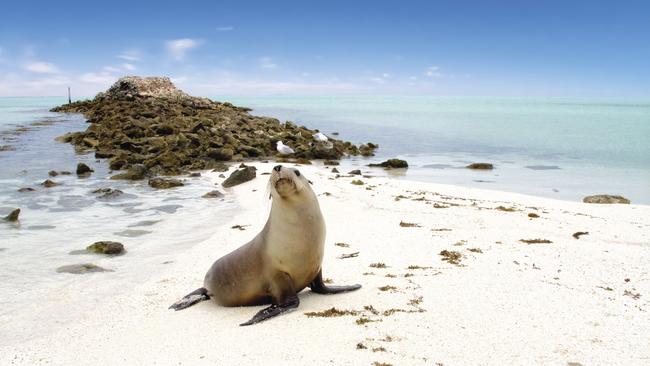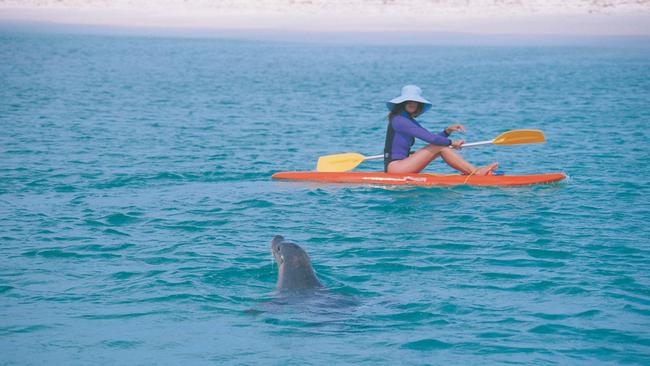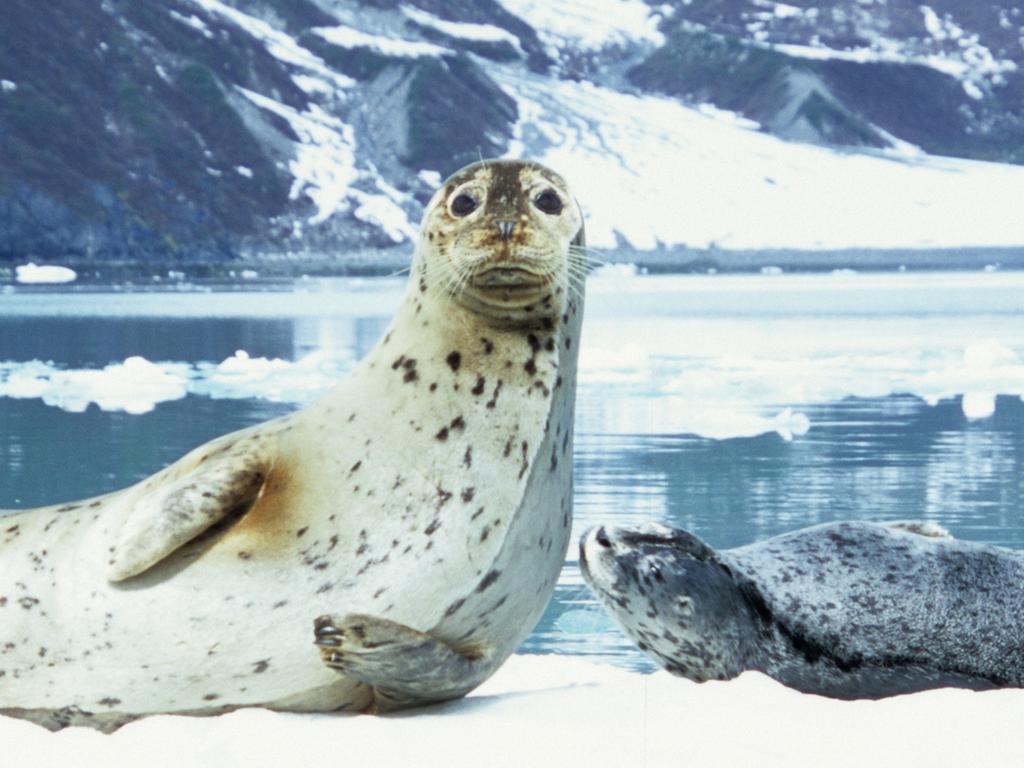Houtman Abrolhos Islands the scene of Batavia mutiny and murder
This idyllic archipelago off the West Australian coast has bloody past.

Spanning the extremes from brutal to beautiful, the Houtman Abrolhos hide one of Australia’s most morbidly fascinating incidents beneath its marbled, swirling seascape. Almost 400 years ago, in 1629, Dutch East India Company’s flagship Batavia, laden with chests of valuables and silver coins to trade for goods in Indonesia, struck a reef and sank in this archipelago off the mid-west coast.
Dozens of passengers died, but the tragedy of the shipwreck was soon overshadowed by a nightmarish mutiny that killed 125 men, women and children in Australia’s first (and worst) mass murder. The mixed group of sailors, soldiers and civilians had been unwittingly left at the mercy of a treacherous deputy officer, who assumed control when the commander, the skipper and a small crew sailed away on a longboat to seek help. For two grim months, the survivors either joined the rebels or became their victims of rape or slaughter, until a rescue boat finally arrived and the mutineers were captured and hanged.

If only the navigators had heeded the warning of mariner Frederick von Houtman, who nearly smashed into the reef a decade earlier while mapping the southern half of present-day Western Australia. On his chart he marked “abrolhos”, believed to be a contraction of “abre os olhos”, Portuguese for “open your eyes”.
The advice still holds true today. Opening your eyes to this scattered chain of islands, the grisly past and stunning setting reveals a national treasure. Much of the land is off-limits as conservation habitat, but the accessible areas are rich in history, wildlife and activities. On West Wallabi are the ruins of the first European structure on Australian soil, a fort built by mercenaries from the Batavia who had been sent there to find fresh water but then fought back to end the mutiny.
Remnants of the ship, and other wrecks from centuries ago, can also be explored on guided tours.

Eco Abrolhos, a small vessel offering five-night cruises, devotes a full day to the Batavia’s significant sites on land and underwater. Weather permitting, guests can snorkel or take a glass-bottom boat to see the jettisoned cannons, anchors and ballast stones. On Beacon Island, they learn about the archaeological digs that have found mass graves and evidence of the gallows. On a lighter note, the 32-passenger outings offer crayfishing, birdwatching, swimming with sea lions, excursions to pearl farms and fishing communities, and feasts of freshly caught seafood, served with WA wines.
“Most people, even some locals, have never heard of the Abrolhos, but it’s slowly getting more known,” says Jay Cox, co-owner of Eco Abrolhos Cruises. “We used to do 12 expeditions a year, but they kept selling out so we’ve doubled it.”
Several other ships briefly visit the islands on west coast itineraries, on the way to or from the Kimberley. Geraldton-based Abrolhos Adventures runs day trips by catamaran, fishing charters and live-aboard holidays on a 65ft boat. In August, the company will launch floating accommodation on a 10-passenger barge, equipped with jet skis, a diving vessel and a shaded top-deck bar.
“The idea is to fly from Perth, Kalbarri or Geraldton, arrive at East Wallabi Island, where you will be greeted by our staff and transfer vessel, and then we go back to the barge and settle in,” says Josh Johnson, co-owner, Abrolhos Adventures. “From here, the itinerary can be set or you can tell us what you want, from fishing, craypot pulls, sightseeing, snorkelling the Batavia, checking out the fort, lazing on the beach, or just hang out at the barge and take in the serenity and enjoy a wine or beer.”
Scenic flights are another way to view the sights. On a tour with Geraldton Air Charter, we spot whales breaching as our small plane tracks the 122 tiny, mostly uninhabited islands. (Counting the smallest clumps of limestone, Parks and Wildlife Service recognises 210 islands, including 189 within Houtman Abrolhos Islands National Park.)

The GA-8 Airvan lands on the red gravel airstrip of East Wallabi for an afternoon at the deserted Turtle Bay, where colourful coral is swimming distance from the shore. Our pilot, Polo, describes the Abrolhos as a “magic spot” of the Indian Ocean.
“This is the southernmost location in the Southern Hemisphere to see giant coral reef systems and the northernmost habitat to see Australian sea lions,” he says.
The sea lion population is estimated at only 90, but green turtles, rays, dolphins and migrating humpbacks are commonly encountered. With the warm Leeuwin Current flowing from the north and colder water from the south, tropical fish and bigger temperate fish mingle in the same natural aquarium.
Polo leads a nature walk to spot native tammar wallabies, which have adapted to drink sea water to survive the dry summers. We spot two of the marsupials foraging in the shrubs, as well as spiny-tailed skinks that live among the coral rubble covering the scrubby landscape. Other endemic species include the Abrolhos dwarf bearded dragon and southern bush rat. An osprey has made its tall, messy nest on the ground due to the lack of predators. This feral-free environment makes the Abrolhos an appealing site for breeding seabirds, attracting more than a million pairs, according to the federal Department of Environment, including many vulnerable and endangered species.

One of the world’s rarest birds, the Australian lesser noddy, breeds only on Wooded Island. Sooty terns, which vanished from the region for 70 years, have mysteriously returned to re-establish a colony. The ground-dwelling Abrolhos painted button-quail exists on seven of the islands but is expected to be extinct within 20 years.
The return flight circles around Hutt Lagoon, shining perfectly pink, as advertised. The hue is created by the microalgae that produce betacarotene, which is harvested within the lake in rectangular pools. As the world’s largest algae farm, the bordered sections of water, coloured bright yellow, red or brown, contrast the curves of this natural phenomenon and the adjacent blue ocean.
Geraldton Air Charter’s chief pilot Wendy Mann, who learned to fly in the 1970s when her husband traded in two tractors for a Cessna, wishes more locals would discover the region. The company, which recently downsized from 11 to eight planes, used to book 8000 Chinese tourists a year but only a few hundred Australians.
“We do tours of the Abrolhos because it really is such a beautiful part of the world, rich in history and natural beauty,” she says. “Pristine and unspoilt, it’s Australia’s best kept secret.”
In the know
The Abrolhos Islands are 60km off WA’s Coral Coast, a 20-minute flight from Geraldton. Geraldton Air Charter’s day trip, including a flyover of Hutt Lagoon, is priced from $530 a person.
Eco Abrolhos expeditions start at $2600 a person, twin-share. The new barge experience will cost $600 a person per day, including activities and drinks, plus flights ($170 each way from Geraldton, $340 from Perth).
The Gerald Apartment Hotel in Geraldton has guestrooms from $230 a night.
Louise Goldsbury was a guest of Australia’s Coral Coast and Tourism Western Australia.



